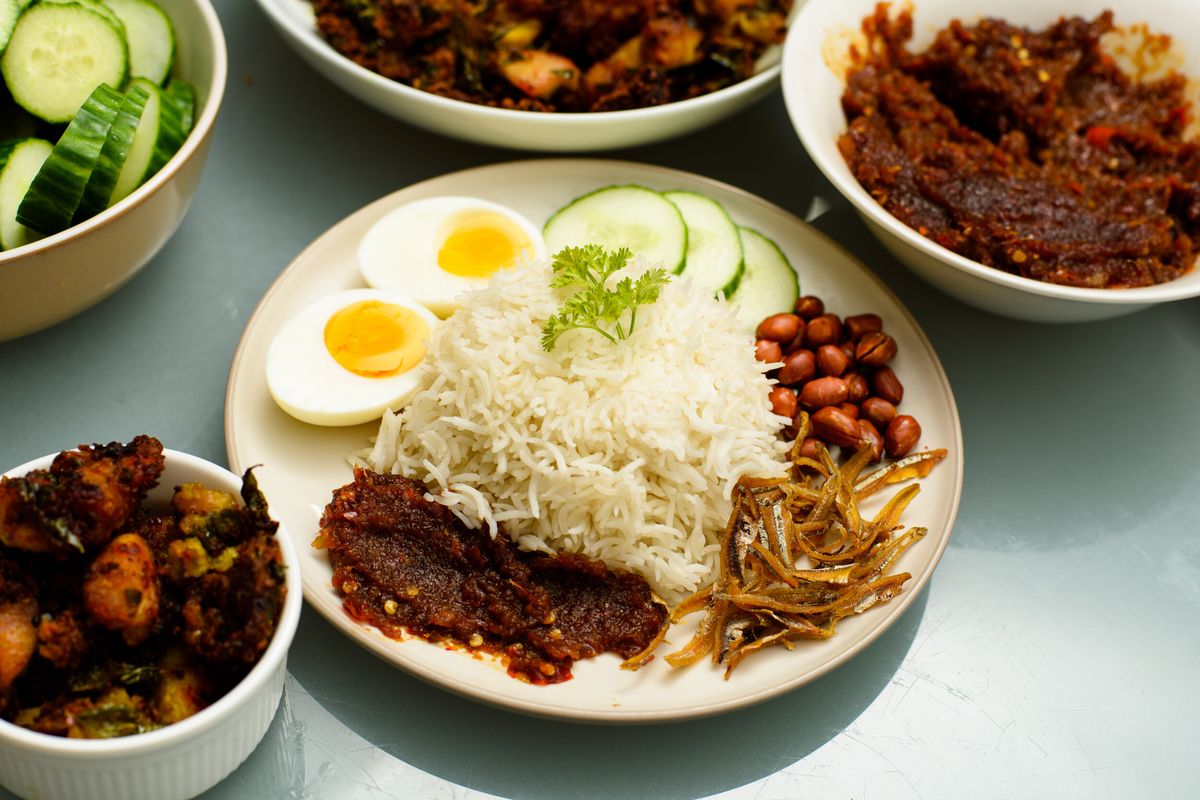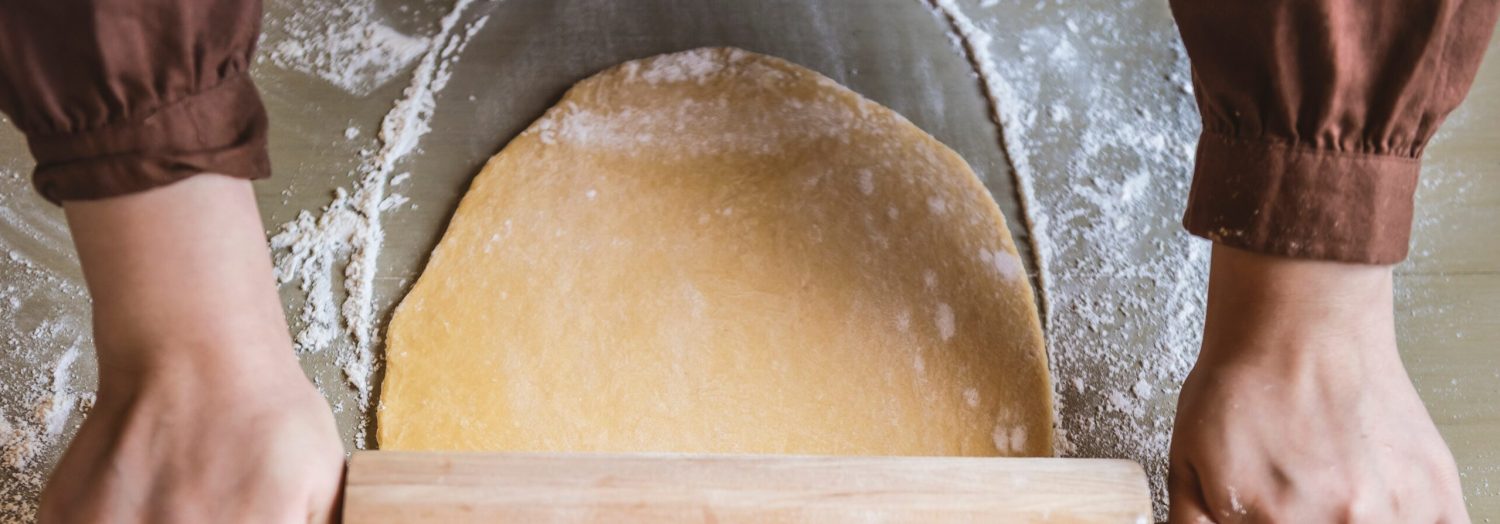Nasi lemak is a beloved Malaysian dish that combines fragrant coconut rice with a spicy sambal, crispy fried anchovies, boiled eggs, fresh cucumber slices, and roasted peanuts. This dish is often enjoyed for breakfast but can be eaten at any time of the day. The combination of flavors and textures makes it a truly satisfying meal.
Some ingredients in this recipe might not be commonly found in every household. Pandan leaves are used to infuse the rice with a unique aroma and can be found in Asian grocery stores. Tamarind paste adds a tangy flavor to the sambal and is also available in Asian markets. Dried anchovies are essential for the sambal and can be found in the seafood section of Asian supermarkets.

Ingredients For Malaysian Nasi Lemak Recipe
Jasmine rice: A fragrant long-grain rice that is essential for the coconut rice.
Coconut milk: Adds a rich, creamy texture to the rice.
Water: Used to cook the rice.
Salt: Enhances the flavor of the rice and sambal.
Pandan leaves: Infuse the rice with a unique aroma.
Dried anchovies: Provide a crispy texture and salty flavor to the sambal.
Oil: Used for frying the anchovies and sautéing the onions.
Onion: Adds sweetness and depth to the sambal.
Chili paste: Brings heat and flavor to the sambal.
Tamarind paste: Adds a tangy flavor to the sambal.
Sugar: Balances the flavors in the sambal.
Boiled eggs: Provide protein and a creamy texture.
Cucumber: Adds freshness and crunch to the dish.
Roasted peanuts: Offer a nutty flavor and crunchy texture.
Technique Tip for This Recipe
When preparing coconut rice, ensure you rinse the jasmine rice thoroughly until the water runs clear. This removes excess starch and prevents the rice from becoming too sticky. Additionally, tying the pandan leaves into a knot helps to release their fragrance more effectively, infusing the rice with a subtle, aromatic flavor. For the sambal, fry the anchovies until they are crispy to add a delightful crunch to the dish. When sautéing the onions, cook them until they are just translucent to avoid burning, which can impart a bitter taste. Finally, when adding the chili paste, cook it until the oil separates to ensure the flavors are well-developed and the paste is fully cooked.
Suggested Side Dishes
Alternative Ingredients
jasmine rice - Substitute with basmati rice: Basmati rice has a similar texture and aroma, making it a good alternative for jasmine rice.
coconut milk - Substitute with almond milk with coconut extract: Almond milk with coconut extract can mimic the flavor of coconut milk while being lighter.
pandan leaves - Substitute with vanilla extract: Vanilla extract can provide a similar aromatic quality if pandan leaves are unavailable.
dried anchovies - Substitute with dried shrimp: Dried shrimp can offer a similar umami flavor and texture as dried anchovies.
chili paste - Substitute with sriracha sauce: Sriracha sauce can provide a similar heat and flavor profile to chili paste.
tamarind paste - Substitute with lemon juice and brown sugar: A mix of lemon juice and brown sugar can replicate the tangy and slightly sweet flavor of tamarind paste.
sugar - Substitute with honey: Honey can provide a similar sweetness and depth of flavor as sugar.
boiled eggs - Substitute with poached eggs: Poached eggs can offer a similar texture and richness as boiled eggs.
cucumber - Substitute with zucchini: Zucchini can provide a similar crunch and mild flavor as cucumber.
roasted peanuts - Substitute with roasted cashews: Roasted cashews can offer a similar crunch and nutty flavor as roasted peanuts.
Other Alternative Recipes Similar to This Dish
How To Store / Freeze This Dish
- Allow the coconut rice and sambal to cool completely before storing. This prevents condensation, which can make the food soggy.
- Store the coconut rice in an airtight container. It can be kept in the refrigerator for up to 4 days.
- For the sambal, place it in a separate airtight container. It can be refrigerated for up to a week.
- If you want to freeze the coconut rice, portion it into individual servings and place them in freezer-safe bags or containers. Label with the date and freeze for up to 2 months.
- The sambal can also be frozen. Portion it into small containers or ice cube trays for easy use. Once frozen, transfer the cubes to a freezer bag. It can be stored for up to 3 months.
- To reheat the coconut rice, sprinkle a little water over it and microwave on medium heat until warm. Alternatively, you can steam it for a few minutes.
- Reheat the sambal in a pan over low heat until it reaches the desired temperature. Stir occasionally to prevent burning.
- Store the boiled eggs in the refrigerator in a covered container. They can last up to a week.
- Keep the sliced cucumber in an airtight container in the refrigerator. It is best consumed within 2 days to maintain its freshness.
- Store the roasted peanuts in an airtight container at room temperature. They can last for several weeks.
How To Reheat Leftovers
Microwave Method:
- Place the coconut rice in a microwave-safe dish. Sprinkle a few drops of water over the rice to keep it moist.
- Cover the dish with a microwave-safe lid or a damp paper towel.
- Heat on medium power for 2-3 minutes, stirring halfway through to ensure even heating.
- For the sambal, place it in a separate microwave-safe bowl and heat on medium power for 1-2 minutes, stirring halfway.
- Reheat the boiled eggs by placing them in a bowl of hot water for 5 minutes.
- Serve the reheated components together with fresh cucumber slices and roasted peanuts.
Stovetop Method:
- For the coconut rice, add a splash of water to a non-stick pan and heat over low-medium heat. Stir occasionally to prevent sticking and ensure even heating.
- Reheat the sambal in a separate pan over low heat, stirring frequently until warmed through.
- To reheat the boiled eggs, place them in a pot of hot water for about 5 minutes.
- Serve the reheated components together with fresh cucumber slices and roasted peanuts.
Oven Method:
- Preheat your oven to 350°F (175°C).
- Spread the coconut rice in an oven-safe dish and sprinkle a few drops of water over it. Cover with aluminum foil.
- Place the sambal in a separate oven-safe dish and cover with foil.
- Heat both dishes in the oven for about 15-20 minutes, or until thoroughly warmed.
- Reheat the boiled eggs by placing them in a bowl of hot water for 5 minutes.
- Serve the reheated components together with fresh cucumber slices and roasted peanuts.
Steamer Method:
- Place the coconut rice in a heatproof dish and set it in a steamer basket.
- Steam over boiling water for about 5-10 minutes, or until heated through.
- For the sambal, place it in a separate heatproof dish and steam for 5-7 minutes.
- Reheat the boiled eggs by placing them in a bowl of hot water for 5 minutes.
- Serve the reheated components together with fresh cucumber slices and roasted peanuts.
Best Tools for This Recipe
Rice cooker: Essential for cooking the jasmine rice with coconut milk, water, salt, and pandan leaves to achieve perfectly cooked coconut rice.
Pan: Used for frying the anchovies until crispy and for sautéing the onions and cooking the sambal.
Spatula: Handy for stirring the rice in the rice cooker and for mixing ingredients in the pan while making the sambal.
Knife: Necessary for chopping the onions and slicing the cucumber.
Cutting board: Provides a stable surface for chopping onions and slicing cucumber.
Measuring cups: Used to measure the rice, coconut milk, water, and other ingredients accurately.
Measuring spoons: Essential for measuring smaller quantities of ingredients like salt, sugar, and chili paste.
Strainer: Useful for rinsing and draining the dried anchovies before frying.
Serving plates: Needed for presenting the final dish with coconut rice, sambal, boiled eggs, cucumber slices, and roasted peanuts.
Tongs: Useful for handling the boiled eggs and placing them on the serving plates.
Bowl: Handy for mixing the tamarind paste with water before adding it to the sambal.
How to Save Time on Making This Recipe
Rinse rice efficiently: Use a fine-mesh strainer to quickly rinse the jasmine rice until the water runs clear.
Pre-make sambal: Prepare the sambal in advance and store it in the fridge for up to a week.
Use a rice cooker: Let the rice cooker handle the coconut rice while you focus on other tasks.
Boil eggs ahead: Boil and peel the eggs the night before to save time.
Pre-slice cucumbers: Slice the cucumbers and store them in an airtight container in the fridge.

Malaysian Nasi Lemak Recipe
Ingredients
Coconut Rice
- 2 cups Jasmine rice
- 1 cup Coconut milk
- 1 cup Water
- 1 teaspoon Salt
- 2 pcs Pandan leaves tied in a knot
Sambal
- 1 cup Dried anchovies rinsed and drained
- 2 tablespoon Oil
- 1 cup Onion chopped
- 1 tablespoon Chili paste
- 1 tablespoon Tamarind paste diluted in ¼ cup water
- 1 tablespoon Sugar
- 1 teaspoon Salt
Accompaniments
- 4 pcs Boiled eggs halved
- 1 cup Cucumber sliced
- 1 cup Roasted peanuts
Instructions
- 1. Rinse the rice until the water runs clear. Combine rice, coconut milk, water, salt, and pandan leaves in a rice cooker. Cook until rice is done.
- 2. For the sambal, fry the anchovies in oil until crispy. Remove and set aside.
- 3. In the same pan, sauté onions until translucent. Add chili paste and cook until oil separates.
- 4. Add tamarind paste, sugar, and salt. Cook for a few minutes. Add the fried anchovies back in and mix well.
- 5. Serve the coconut rice with sambal, boiled eggs, cucumber slices, and roasted peanuts.
Nutritional Value
Keywords
Suggested Appetizers and Desserts
Check out these recipes too!
- Baja Sauce Recipe for Fish or Shrimp Tacos10 Minutes
- Garlic Naan Recipe30 Minutes
- Swedish Hard Tack Recipe45 Minutes
- Dutch Crunch Rolls Recipe45 Minutes
- Strawberry Glazed Pie Recipe50 Minutes
- Spanakopita Greek Spinach Pie Recipe1 Hours 15 Minutes
- Breakfast Rice Recipe30 Minutes
- Italian Rice Pie Recipe1 Hours 20 Minutes
- Cottage Cheese Bread Recipe1 Hours
- Savory Parmesan French Toast Recipe25 Minutes
- Applesauce Bread Recipe1 Hours
- Vegan Pumpkin Pie Smoothie Recipe10 Minutes


Leave a Reply